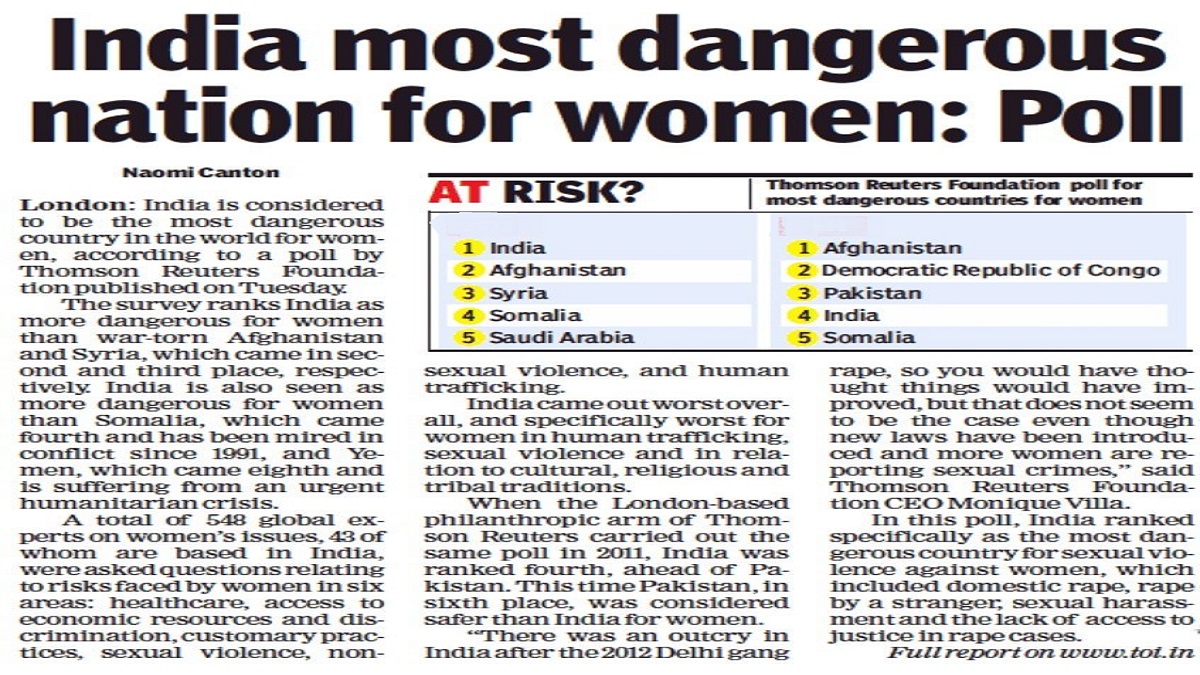In recent years, safety concerns for women have grown worldwide, as many countries continue to struggle with issues of gender-based violence, discrimination, and inadequate legal protection. Unsafe environments, fueled by factors like cultural norms, lack of effective law enforcement, and limited access to justice, contribute to the heightened risk women face daily. In some regions, societal expectations and deeply ingrained patriarchy further complicate efforts to promote women’s safety and equality. This article explores countries where women experience significant threats to their well-being and rights, shedding light on the urgent need for policy changes, social reform, and global awareness to improve safety for women everywhere. Check Unsafe Country for Women list below:
Unsafe Country for Women List (Latest Updated)
Creating a list of the most unsafe countries for women requires examining various factors, including rates of violence, discrimination, legal rights, healthcare access, and economic opportunities. Organizations like the United Nations, World Economic Forum, and various NGOs publish reports on gender inequality and violence, helping to assess women’s safety worldwide. Here are some countries often highlighted for gender-based issues, with the key challenges women face in each:
1. Afghanistan
- Factors: Political instability, restricted rights, forced marriages, lack of healthcare access, gender-based violence.
- Details: Since the Taliban regained control, women face restricted rights, including limitations on education, employment, and freedom of movement. Violence and forced marriages are prevalent, and legal protections for women are minimal.
2. Democratic Republic of the Congo (DRC)
- Factors: Sexual violence, lack of legal protections, healthcare access issues.
- Details: Ongoing conflicts and instability contribute to widespread sexual violence. Despite efforts to protect women’s rights, legal enforcement is weak, and many perpetrators go unpunished.
3. India
- Factors: High rates of domestic violence, human trafficking, sexual assault, and a strong prevalence of patriarchy.
- Details: Cases of sexual assault and harassment are frequently reported, and societal norms often discourage women from speaking out. Human trafficking, especially of young girls, remains a critical issue, along with honor killings in some rural areas.
4. Somalia
- Factors: Gender-based violence, lack of legal rights, forced marriages, limited healthcare.
- Details: With limited government control in some regions, law enforcement against gender-based crimes is weak. Female genital mutilation (FGM) is common, and women have minimal legal protections or recourse for domestic violence.
5. Syria
- Factors: Conflict-driven sexual violence, limited rights, and lack of healthcare.
- Details: Years of conflict have led to increased violence against women, especially in refugee camps where they are vulnerable to abuse. Healthcare for women is severely impacted by war, and legal systems do not effectively protect women’s rights.
6. Pakistan
- Factors: Domestic violence, honor killings, forced marriages, societal discrimination.
- Details: Cultural norms around gender roles are deeply entrenched, and honor killings, child marriages, and domestic violence continue to affect many women, particularly in rural areas. Laws exist but are often poorly enforced.
7. South Sudan
- Factors: Sexual violence, limited access to justice, healthcare barriers.
- Details: With high rates of sexual violence linked to ongoing conflict, women in South Sudan face significant challenges, including inadequate access to justice or healthcare. Forced marriages are also prevalent.
8. Yemen
- Factors: Political instability, domestic violence, child marriage, limited legal protections.
- Details: The ongoing conflict has worsened living conditions and safety for women, with increased rates of gender-based violence, child marriages, and healthcare challenges. Laws protecting women are virtually nonexistent.
9. Nigeria
- Factors: Terrorism-related violence, child marriage, sexual assault, domestic violence.
- Details: Boko Haram and other terrorist groups have targeted women and girls for abduction and abuse. Domestic violence is common, and early marriage remains prevalent, especially in rural areas.
10. Brazil
- Factors: High rates of femicide, domestic violence, sexual assault.
- Details: Brazil reports high rates of femicide and domestic violence, with a lack of effective enforcement of protective laws. While some legal measures are in place, the rate of crimes against women remains concerning.
Key Organizations and Reports to Reference
- Thomson Reuters Foundation’s Poll on the most dangerous countries for women.
- Global Gender Gap Report by the World Economic Forum.
- World Health Organization (WHO) reports on violence against women.
- UN Women reports on gender-based violence and discrimination.
These countries present complex challenges for women’s rights and safety. Efforts to improve conditions include international pressure, domestic policy reform, and support from NGOs dedicated to promoting gender equality and security for women.
FAQs
Q. 1 What factors determine if a country is considered unsafe for women?
Ans. The criteria often include rates of gender-based violence, sexual harassment, workplace discrimination, restrictions on women’s rights, and lack of legal protection or enforcement for women. Additionally, factors like access to healthcare, educational opportunities, and freedom of movement may also be considered.
Q. 2 Which sources or data are used to determine safety rankings?
Ans. Reports are often based on data from global organizations like the World Health Organization (WHO), United Nations, World Economic Forum, and various human rights organizations. Surveys and studies on violence against women, safety indices, and gender equality measures also contribute to the assessment.
Q. 3 Are there specific countries that are consistently ranked as unsafe for women?
Ans. Some countries repeatedly appear in these reports due to ongoing challenges with women’s safety, legal rights, and gender equality. Countries in conflict zones, regions with limited legal protections, or places with high rates of violence against women may be more frequently ranked as unsafe.
Q.4 How can conditions improve for women in countries ranked as unsafe?
Ans. Improvement may involve legal reforms to protect women’s rights, societal efforts to address gender-based violence, educational programs to reduce discrimination, and support from global organizations. Economic empowerment and ensuring safe public spaces are also critical factors.
Q. 5 Can travel advisories for women change based on these rankings?
Ans. Yes, some countries update travel advisories based on the safety levels for women in certain regions, especially for solo travelers. Advisories may suggest precautions or even recommend against travel to areas where women’s safety is a concern.

